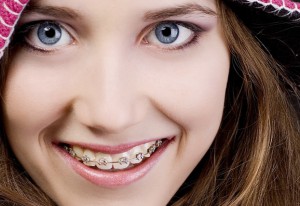Treatment at orthodontist involves compulsory visits to your general practitioner of dentistry for professional teeth cleaning every 3-6 months. It will help to avoid possible weakening of tooth enamel as a result of insufficient oral hygiene and periodontal diseases.
Patients who suffer from any of the periodontal diseases need supportive treatment at periodontist before orthodontic treatment, in its course and after it is completed.
Teeth, restored with filling materials, pulpless teeth, teeth having cracks or enamel defects are extra fragile. That is why, while braces are being removed, enamel can chip, or filling material integrity can be affected, sometimes a considerable part of crown may chip off.
Pulpless teeth make the process of orthodontic treatment a bit slower and more challenging. Treatment must be performed in an extra careful manner, so that some possible complications with tissues surrounding teeth do not occur.
Allergy. If you are allergic to anything, you should report this to your dentist directly. Depending on the type of allergic response, orthodontist will either advises you to go for a check-up at allergist or will perform the necessary tests himself. When choosing braces, titanium-made appliances are preferred, as they have been specially designed for people who develop allergy to various metals.
Problems related to temporo-mandibular joint are solved with the help of a respective specialist. To make a diagnosis, a thorough examination must be carried out. Quite often, an adequate orthodontic treatment can normalize condylar head position, functions of masticatory muscles, improving their condition.
Combined (orthodontic-surgical) treatment is necessary for adult patients with full-blown (gnathic) jaw form of posterior, posterior open and mesial occlusion. In such cases advice of oral and maxillofacial surgeon is necessary.
In case of chronic systemic diseases, orthodontist should be immediately informed, so that your treatment plan can be approved by your consulting physician or adjusted, if necessary.
Application of extraoral appliances (facebows, masks) is only possible at the time of relaxing activities, when your child is sleeping, doing the homework, reading or watching TV. In order to avoid facial traumas they are not to be used during sports and outdoor activities.
Even if you experience the slightest discomfort or if the orthodontic appliance brakes down or becomes displaced, you should immediately seek help of your consulting physician or doctor on duty.
What you must DO, if you have braces fitted:
You should clean your teeth in front of the mirror after each meal, using special brushes as well as interdental brushes.
During treatment time you should avoid eating nuts, sunflower seeds, popcorn, as they may damage the appliance.
You shouldn’t bite hard fruit and vegetables, for example carrot, apples and pears, but cut them into small bites instead. The same is also true about tough meat and all other products you may need to bite off. It is recommended that you always carry a small jack-knife with you.
During treatment time you should avoid foodstuffs that tend to stick to teeth: halva, toffee and the like, as they are difficult to clean teeth from and may cause breakdown of braces.
You should not finish your meal with sweets or eat sweets and suck lollipops in the time between meals. You are strongly encouraged to avoid eating sweets before going to bed, as secretion of saliva is considerably reduced at night and self-cleaning of oral cavity is lower, which contributes to teeth decay.
You should avoid extremely cold and hot foods, as temperature difference can make braces come unstuck and influences adversely properties of orthodontic archwires.
When aesthetic braces are chosen for treatment, in order to avoid colouring of the appliance you should avoid drinking strong coffee and tea as well as eating currant jam etc.
You should not worry if during the first 3-7 days after placement of braces, feeling of discomfort or pain occur, or even if mucous membrane of cheeks and lips are affected. To make it easier for patients to get comfortably adjusted to their braces, they are covered with special wax during the earliest treatment stage.
If the appliance comes unstuck, you should keep it and get an appointment with your dentist directly. The same should be done if the orthodontic band becomes displaced.

